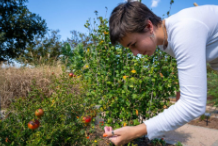Across the Midwest, some city codes threaten people with fines for having milkweed on their property. But experts say many places have dropped those rules to support monarchs with urban and suburban butterfly gardens.
Oliver Hernandez’s front yard hums with plenty of bugs for the 12-year-old and his friends to find.
“It’s kind of fun just knowing that there are lots of caterpillars in the yard,” he said.
About a third of the yard looks like a teeny swath of prairie, with wild indigo, bee balm and, until recently, a key plant for monarch butterflies: common milkweed.
Last fall, the city of Overland Park told Oliver’s mother to rip the milkweed out of her pollinator garden.
That bummed Oliver because it’s a plant where brightly striped yellow, black and white caterpillars would appear each summer, grow fat on leaves and transform into the feather-light marvels of nature most famous for what they do next.
“They are pretty,” he said. “Also, whenever they become butterflies, they fly to Mexico. I think that’s pretty cool.”
Across the U.S., milkweed bans are disappearing. But this Kansas suburb and plenty of other towns and cities across the Midwest continue to define it in their city codes as flora non-grata.
Sometimes city, county and state rules conflict, leaving homeowners to navigate mixed messages from local governments that can’t see eye-to-eye on whether to promote milkweed or kill it off.
City workers may not have much heart for enforcing these rules. The plight of the continent’s dwindling monarch population is, after all, well-known.
Ginger Werp, Oliver’s mother, got the impression that the city worker who showed up at her door in late September didn’t really like telling her to remove environmentally beneficial plants.
“Our world is becoming degraded and needs us to change,” Werp said. “Not all of the cities in Johnson County have this rule.”
In fact, Werp points out, this county encourages homeowners to plant common milkweed and reimburses part of the cost for people who replace grass turf with native plants — including this one. The goal is to feed wildlife and fill the soil with deep roots that absorb stormwater and slow the pace of pollution washing into streams.
Werp knows about the program because she works at a nonprofit organization that, among other things, helps the county run it.
And she knows about native plants because wading into prairies to identify species and collect seeds for habitat restoration projects is her full-time job.
Oliver’s front-yard insectary likely came to the city’s attention because his mother and her neighbors have very different tastes in landscaping.
On a street lined with neatly trimmed bushes and traditional lawns, Werp’s little meadow is perhaps 12 feet by 7 feet. The tallest plants, native Maximilian sunflowers, tower above her head.
Instead of mulching the bed in the typical Suburban style (with cedar chips or other store-bought options), Werp lets fallen sycamore leaves mulch her plot.
Rather than chopping down plant stalks in the fall, she lets them stand, so her family can watch finches raid the garden for seeds all winter.
Werp knows this isn’t everyone’s cup of tea.
“I’ve had some uncomfortable conversations with neighbors about it,” she said of her flower bed. “But it doesn’t bother me. … I think it’s pretty, I think it’s fun. My son and I have a good time out here.”
She supposes a neighbor became concerned that her naturalistic landscaping would hurt home resale values.
But when a city worker showed up to inspect her handiwork, he said most of the plants could stay. She only had to remove the contraband common milkweed, Asclepias syriaca.
Werp agreed and the matter ended there.
Had she refused, the city could have sent someone to remove the milkweed and charge her for the work.
Overland Park’s code allows it to prosecute violators, though it’s not clear that the city would actually pursue something so stringent against a butterfly enthusiast. The penalties include a fine of $50 to $500 and/or up to 10 days in jail.
Other cities in Kansas and nearby states frown on milkweed, too — usually common milkweed but sometimes its relatives, as well.
St. Louis, Lamar and Sunset Hills, Missouri, put landowners who tolerate milkweed on notice, as do Huron and Redfield, South Dakota, which define milkweeds as “dangerous and unhealthy.”
Winfield, Kansas, puts common milkweed on its list of “rank” plants that harbor rats and insects, pose fire risks or blight neighborhoods.
Sometimes, city codes hinge on context.
Prairie Village lists common milkweed as a no-no, followed immediately by this caveat: “Native plants contained in a native garden, such as common milkweed and other pollinators (sic), would be considered a cultivated garden and not classified as a rank weed.”
City bans on milkweed are on the way out, the National Wildlife Federation says, a fact that it welcomes.
“They have been historically very, very common,” said Mary Phillips, head of the group’s Garden for Wildlife program that aims to integrate habitat into cities and suburbs. “Particularly in the central United States.”
She traces that history to the region’s agriculture. Milkweed can sicken livestock when they eat enough of it. Animals tend to steer clear of the toxic plants, but accidental poisonings do happen, particularly if milkweed infiltrates a hayfield and gets cut, dried and served up to livestock mixed into their hay.
Cities that no longer worry about keeping cattle safe have nevertheless retained the historical opposition to milkweed.
“The real trend is that those bans are being reversed,” Phillips said. “There’s a lot of pushback to get those overturned.”
In 2017, Illinois passed two state laws. One forced cities and counties to drop milkweed bans. The other declared milkweed the state wildflower.
Illinois cities such as Ottawa still have bans on their books, but the state law trumps it.
Asclepias syriaca, or common milkweed, is the species that cities most commonly target.
This species spreads not just through its seeds, but also through underground runners.
It takes work to control it in a flower garden, which might explain city bans where they still exist.
Yet the same city codes usually allow aggressive, commercially profitable species that wreak environmental damage, such as the invasive ornamental pear trees that Johnson County Park and Recreation workers are racing to control.
The reality is, many cities may not have anyone on staff who knows when or why milkweed was banned.
An Overland Park spokesperson said the city considers common milkweed a noxious weed because the Kansas Department of Agriculture does.
But the state agency refuted that. It says all Kansas milkweeds are “native and beneficial.”
“As far as we know it has never been listed as a noxious weed and there is no indication that there is any interest in listing it as noxious,” a Department of Agriculture spokeswoman said by email. “While it’s not healthy for cattle to eat, they generally avoid it.”
The center of the country is a significant flyway for migrating monarchs. And on their way north from Mexico each spring, they lay eggs.
These famous travelers — by some counts, they were five times as numerous in the 1990s — can’t survive without milkweed.
A monarch butterfly can happily nectar on the blossoms of a wide variety of plant species, but its offspring eat just one thing: milkweed leaves. Without that, the females can’t produce descendants any more than humans can rear babies without breast milk or formula.
But milkweed has gotten harder to find.
“That entire (central) flyway was so heavy with milkweed many, many years ago,” Phillips said.
But today, as Monarch Watch at the University of Kansas notes, genetically modified corn and soybeans allow aggressive glyphosate herbicide (sold most commonly under the brand name Roundup) application that kills, among other things, milkweed. The plants have disappeared from tens of millions of acres of cropland.
Monarch Watch founder Chip Taylor and other researchers wrote in 2020 that restoring milkweed “is the conservation measure that will have the greatest impact” for helping the insects.
Monarch Watch distributes milkweed plants for habitat restoration, encourages the creation of pollinator gardens in cities and suburbs, and mails free plants to eager schools.
Common milkweed holds particular significance.
A 2018 study by researchers at Iowa State University and the USDA compared nine types of milkweed at 10 sites across Iowa from 2015 to 2017. They found Asclepias syriaca was one of two types where monarchs laid the most eggs.
Its decline makes some homeowners passionate about offering their yards as refuge by planting the long-maligned species, with its large leaves and spheres of pink blooms.
As some governments see the plant in a new light, it can lead to conflicting messages, such as the discrepancy between Johnson County and Overland Park.
In 2014, Canada’s most populous province, Ontario, ended its battle against common milkweed. But as recently as last summer, a butterfly enthusiast there lost her milkweed-heavy pollinator garden to Toronto workers with weed wackers enforcing the city’s landscaping rules.
Lawrence lists common milkweed as a weed in its city code, but its parks and recreation department grows the plant in pollinator gardens.
“Our stance is that common milkweed in a properly maintained garden is perfectly acceptable,” a city spokeswoman said by email.
The city, which is part of a National Wildlife Federation pledge to support monarchs, says it can enforce its weed rule when properties aren’t properly tended.
But a citizen advisory board has asked the city commission to strike milkweed and other plants from Lawrence’s list of 56 weed species. It recommends using the state’s far shorter list.
“The list has kind of grown (over the decades) and nobody knows where a lot of this stuff came from,” said advisory board vice chairman Ben Sikes, a biologist. “Many of the species that are on there, we know are native species. Many of them are important for habitat or for food for native animals and insects.”
For example, the city weed list includes western ironweed and hoary vervain — popular food troughs for native bees and inchworms with the endearing habit of coating themselves in flower petals.
The Lawrence City Commission hasn’t acted on the recommendation.
From the Kansas News Servivce.




